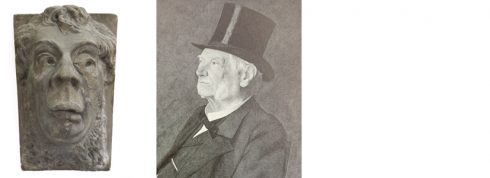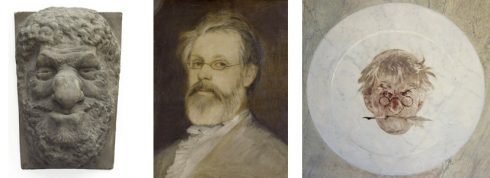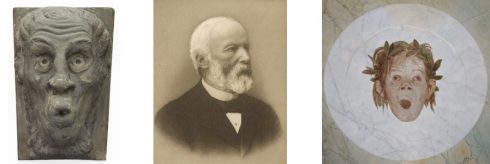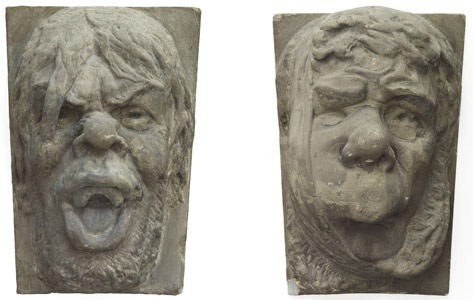What we know, and what we don’t know, about Arnold Böcklin’s grimaces
The six grotesque sandstone faces overlooking the foyer of Kunsthalle Basel have given rise to many rumors and speculations over the years. The works were originally designed in 1871 for the building’s garden facade by famed Basel artist Arnold Böcklin (1827–1901). Today, replicas are mounted in their place, looking down in seeming judgment on the plates of Restaurant Kunsthalle’s guests.
The Fratzen (grimaces) are immensely popular, but readers may not realize that in the past they sparked considerable outrage among Basel’s citizens, to the point that some even demanded they be knocked off the walls. Who were these grumblers? Did they disapprove because they recognized themselves in the distorted faces? It’s time to get to the bottom of things.

Arnold Böcklin: masks for the garden facade of Kunsthalle Basel, 1871. Photos: Serge Hasenböhler
The whole affair began in 1868, a few years before the inauguration of Kunsthalle Basel in 1872. Böcklin had been commissioned to decorate with frescoes the stairwell of the museum on Augustinergasse, in the so-called Berri-Bau, where the Natural History Museum Basel is today. While the work was under way, there were constant complaints and nagging about the fresco designs from the museum’s building and arts commission, in particular, its president, Eduard His-Heusler. But why?
“One has to show a subject quite rough and truthful in order to cause sensation,” Böcklin opined. But his dear friend Jacob Burckhardt—a professor of art history at the University of Basel and an important cultural critic of his time, until recently depicted on the 1000 Swiss franc note—took a different view. Burckhardt, who enjoyed significant status among the museum’s administrators and had originally proposed Böcklin for the job, wished for more gentleness in the works: “One must make concessions to art and sweeten the bitter.”
This know-it-all remark must have annoyed Böcklin, since he immediately thereafter changed his concept for two of the three fresco medallions. To complement the face of the medusa, which already adorned one of them, he created two other faces, which “for lack of a better interpretation, were called the ‘stubborn’ and the ‘stupid criticism.’” Böcklin’s saucy riposte offended the commission considerably. His-Heusler demanded the unsolicited frescoes be erased (which didn’t happen).
Even though the two faces are to be understood as allegories of criticism of artistic freedom and are only indirectly addressing the members of the commission, one of the medallions bears similarities to Friedrich Weber, a Basel copper engraver and member of the commissioning body.

Arnold Böcklin, Bildnis Friedrich Weber, 1869; Kritikus, ‚stubborn criticism‘, 1869; Dumme Kritik, stupid criticism‘, 1869 (f. l. t. r.)
But what does this story have to do with the grimaces at Kunsthalle Basel?
The people of Basel were probably quite astonished when Böcklin presented his sandstone grimaces on the garden facade of Kunsthalle Basel two years later, as they were once again seen as a provocation to his critics—a deliberate defamation arising from a desire for revenge over the museum fresco dispute, which was clearly still simmering. According to Böcklin’s wife, there were demands to chip them off the walls, which only a buying interest of the Strasbourg Museum prevented.
There are a number of possibilities regarding the grimaces’ likely resemblances. According to Margot Bryner-Bender, one portrays Jacob Burckhardt as the “nose-turning critic.”.

Arnold Böcklin, masks for the garden facade of Kunsthalle Basel, 1871; Portrait of Jacob Burckhardt, 1892; former 1000 franc note (f. l. t. r.).
She also notes that the “mask with side-whiskers, . . . with a smooth forehead into which the hair falls in the form of a sweeping curl” looks not unlike the “so-called Cylinder-Bernoulli, the secretary of Kunsthalle Basel at the time” and a well-known local personage. A portrait of Emanuel Bernoulli-Müller painted by Theodor Barth in 1916 is in the collection of the Basler Kunstverein.

Arnold Böcklin, masks for the garden facade of Kunsthalle Basel, 1871; Theodor Barth, Bildnis Emanuel Bernoulli-Müller, 1916 (f. l. t. r.)
Who is being mocked in the other four grimaces? Perhaps two of them are again depictions of the “stubborn” and the “stupid criticism,” this time more pointed and less allegorical than in the frescoes. Did Weber and His-Heusler recognize themselves?

Arnold Böcklin, masks for the garden facade of Kunsthalle Basel, 1871; Bildnis Friedrich Weber, 1869; Kritikus, ‚stubborn criticism‘, 1869 (f. l. t. r.)

Arnold Böcklin, masks for the garden facade of Kunsthalle Basel, 1871; Bildnis Eduard His-Heulser, year book of Basel, 1907; Arnold Böcklin, Kritikus, ‚stupid criticism‘, 1869 (f. l. t. r.)
And what to think of the screaming figure with the straggly hair covering part of his face, or the one with the bandage around his head, as if he is suffering from a bad toothache? If you have a guess as what or who these representations depict, please contact us.

Arnold Böcklin, two masks for the garden facade of Kunsthalle Basel, 1871
Böcklin’s six grimaces, with their grotesquely exaggerated features and presumed reference to his contemporaries, combine caricature with local history. The sandstone sculptures hark back to the historical form of the mascaron (grimace face), which operated somewhere between joke and allegory and served a purely decorative architectural purpose. And in a city as devoted to the Fasnacht (carnival) as Basel, one cannot avoid also associating them with carnival masks, with their humorous and provocative exaggerations.
Böcklin’s revenge was indeed a sweet one, melding as it did artistic wit, critical reflection, and social debate. He would surely be satisfied to know that public affection for the work has ultimately persisted much longer than the kerfuffle that sparked it. To this day, the grimaces are humorous contemporary witnesses of the spirit that for 150 years has shaped Kunsthalle Basel: a hotbed of critical and passionate examination of art, its audiences, and the specific discourses of the moment.
Literature:
-Angela Böcklin. Böcklin Memoiren. Tagebuchblätter von Böcklins Gattin Angela, mit dem gesamten brieflichen Nachlass. Hrsg. von Ferdinand Runkel. Internationale Verlagsanstalt für Kunst & Literatur, Berlin 1910.
–Arnold Böcklin 1827–1901. Gemälde, Zeichnungen Plastiken. Ausstellung zum 150. Geburtstag. Kunstmuseum Basel, 11.06–11.09.1977. Kunstmuseum Basel, Schwabe Verlag, Basel u. Stuttgart 1977
-Arnold Böcklin. Eine Auswahl der hervorragendsten Werke des Künstlers in Photogravüre. Verlag Bruckmann, München 1903.
-Wilhelm Barth. Arnold Böcklin. Huber, Frauenfeld, Leipzig 1928.
-Margot Bryner-Bender. Arnold Böcklins Stellung zum Portrait. Dissertation. Basel 1952.
–Neben meiner Kunst. Flugstudien, Briefe und Persönliches. Hrsg. von Ferdinand Runkel und Carlo Böcklin. Berlin 1909.
-Heinrich Alfred Schmid. Arnold Böcklin. Buchdruckerei Werner-Riehm, Basel, 1922.
-Lukas Gloor. Die Geschichte des Basler Kunstvereins und der Kunsthalle Basel 1839–1988. 150 Jahre zwischen vaterländischer Kunstpflege und modernen Ausstellungen. Basler Kunstverein und Kunsthalle Basel, Basel, 1989.
-Moirandat, Alain: Arnold Böcklin 1827–1901. Gemälde, Zeichnungen Plastiken. Schwabe: Basel, Stuttgart 1977.
-Bryner-Bender, Margot: Arnold Böcklin’s Stellung zum Portrait. Univ. Diss. Basel 1948. Schahl: Basel 1952.
Image-credits:
-Arnold Böcklin’s Kritikus, 1869, und Dumme Kritik, 1869: Kantonale Denkmalpflege Basel-Stadt, Photos Ruedi Walti
-Arnold Böcklin’s masks for the garden facade of Kunsthalle Basel, 1871: Kunsthalle Basel, Photos Serge Hasenböhler